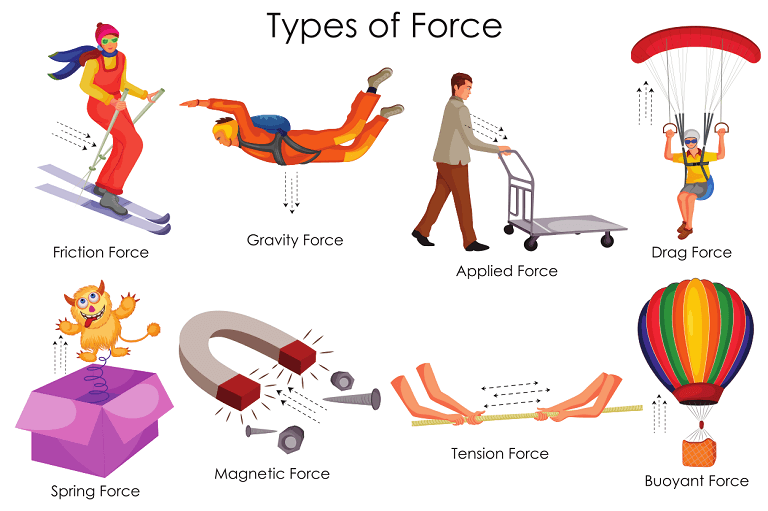
Force and motion with real-life examples for kids
Everything in the entire universe is controlled by force. Planets are moving around in space, the sea is rolling in and out, planes can fly, trains can go, and people can live a comfortable life. But how is it possible? Let’s dive into the mysterious nature of force and motion and find out how the strengths work.
What is a force?
Force is a push and pulls in a specific direction. Even though force acts in every area of life, we rarely realize how it works. Fortunately, we can see the result of its impact. The force can:
- make something move;
- speed up;
- change direction;
- vary shape and size.
Force is pushing or pulling the object in the whole universe. You are participating in the interaction of different types of forces even when you read this article!
Combination of force
Force rarely works alone. There are combinations of different types of forces that affect the universe. First of all, start with an example to show how it works.
Imagine that you are sitting on the football pitch, and one of the footballers is kicking the ball. The ball is flying into the gate, and the fans go wild. Of course, at that moment, we are marveling at the player’s masterpiece. However, we all owe it to a combination of forces. Without various strengths, football wouldn’t even exist.
Three forces make the flying and falling of the ball:
- When a footballer kicks a ball — the force of his throw works;
- Then the ball is falling thanks to the force of gravity which is pulling it down;
- But the ball is not occurring on the ground at a glance. It is slowly falling thanks to the force of air resistance.
Takeaway: there are several types of forces. They are very mysterious and thrilling. See them yourself below!
Contact forces and field forces
Generally, there are contact and field forces. Contact strengths are made when objects touch each other. For example, a leg kicks a ball, or the wind blows against a moving car. All things in contact can exert various forces. Depending on the types of objects in interaction, we give them different names.

Interaction of objects without touching creates field forces. They can make a force at a distance. Such kinds of strengths are natural and very mysterious.
Gravity
It is an invisible force that pulls objects toward the ground. Thus, an apple falls from a tree, thanks to gravity. Gravity is a natural force, which controls everything in the universe — even revolving Earth around the Sun! Each thing has its gravity. The harder an object will pull, the stronger it will fall to the ground. We can feel the force of gravity on roller-coasters. When roller-cars get to the top, gravity pulls it down.
Takeaway: when you throw something, gravity will pull it to the ground. If things had no gravity, they would fly into space.
Tip to note: Newton was the first scientist to write about gravity.
Do you know? Earth is the nearest object to us, which has gravitation, but not the one! The Moon has gravitation, but less than Earth. The gravity of our Sun is the heaviest in our solar system.
Magnetic force
It is another invisible force that can pull and stick some objects to a magnet. Magnets are objects and materials which can produce a magnetic field. They pull on some metals such as iron and nickel. They don’t pull on wood, plastic, copper, or gold. The things which can pull objects are named magnetic. Other things are called non-magnetic.
Do you know? Magnetism is applied in different areas of life. For example, magnets are used in fridges, the doors of refrigerators close and stick tightly with them.
A maglev train can reach 360 mph without an engine, but thanks to magnets! Magnets under the train and on the track push against each other. It is the reason why the train always hovers up to nearly ½ inches above the track. Thus, sets of magnets push the train forward.
Normal force
Sometimes several forces can affect the object, but it remains its characteristics. That happens due to the equilibrium of forces. In that case, a book on the table stays still. It doesn’t move because the gravity that pulls the object down is equal to the force on the table pushing up. The force that keeps the book still is named normal.
Applied force
This is a force that is used to a subject. For example, when you push buttons on your smartphone or close the door.
Frictional force
When two surfaces slide against each other, they stick very slightly together with the help of friction. Some outsides create very little friction, for example, ice and glass. It is easy to move things when a little friction weakly sticks them. By contrast, the more contact between things is, the harder it is to push them.
For example, we can walk across the ground without sliding.
The friction between the ground and wheels of the skateboard helps to do tricks!
Tip to note: A person can not pull a train because there is a more intense force between a train and the ground.
Research on how friction works helps people make scientific breakthroughs. Thus, adding oil between rough surfaces helps slide an iron weight. Oil makes rough surfaces slippery and reduces friction. Oils also save iron from wearing away and reduce friction between moving parts.
Tension force
Tension is a force that is directed on another object. A string or a cable creates this force, for example, when we climb a mountain thanks to the rope.
Spring force
This kind of reactional force is produced when spring is stretched or compressed. Spring is a metal elastic device that can return to its original form after pulling or stretching. Spring force is repulsive when a spring is pressed. And it is attractive when spring is stretched. An example is a trampoline or a diving board.
Resisting force
It helps change, stop or slow a motion. For example, thanks to air resistance, the leaf can float in the wind. When you go swimming, you can notice the water pushing back against your arms and legs as you move forward. It is how water resistance works.
Nuclear force
It is a kind of force that keeps atoms and particles together.
Balanced and unbalanced forces
The other characteristic of force is vital for our comfortable life. We have already told one of the general properties of force: the bigger force, the more reactions will be, but not always. What happens with the subject after forces affect depend on two things:
- How strong are the forces?
- What direction of forces?
Balanced forces are two or more forces that affect one object. If the forces act in opposite directions and have equal strength, their effects cancel each other, and the object will remain still. Planes can fly thanks to balanced forces: air resistance, thrust, lift, and gravity.
If one force is stronger than another, the object will change in motion. Such kinds of forces are called unbalanced. They make objects change in direction, speed, and motion.
How is the force measured?
The main but not the one measure of force is the newton. The one newton equals a force that can accelerate one gram of mass by one centimeter per second squared.
Vector
As we’ve mentioned above, the force is an energy in a certain direction. The force always has a direction. This is very important knowledge, which helps people to predict and control the force’s impact.
Tip to mention: vector is a line with an arrow.
If we dive into physics science, we find out that force has both magnitude and direction. The first one is measured in newtons, and the second one makes force a vector. The direction of force, or vector, is shown as an arrow. Vectors identify the direction of the force, and newtons identify magnitude.
You may also be interested in other “Physics for kids” topics :
- States of matter: what are solids, liquids and gases?
- What is gravity? — Simple explanation for kids
- What is electricity and how does it work?
- Magnets and magnetism: simple introduction for kids
Inertia
Inertia is a property of objects with mass to resist a change in motion or rest. All things have inertia; they resist motion or rest when an outer force affects them. For example, you can feel inertia traveling by train: when the vehicle stops, it continues to move forward sometimes. This is because of inertia. Inertia is often masked by other forces such as friction, resistance, gravity. The more mass a subject has, the more inertia it has.
Force and motion
Motion is movement from one place to another. The force causes motion as force affects objects which start moving but not only. Forces affect the motion in several ways:
- Objects can start moving.
- They can move faster or slower.
- Objects can stop moving.
- They also can change direction or even shape.
When objects start moving faster, they accelerate. This property is called acceleration, which means an increase in speed.
Fun fact: The invisible forces make us giggle or scream. For example, when you ride a roller coaster, the forces lift you and go you downhill. At this time, your stomach lifts upwards and downwards, making you scream and giggle at the same time.
Laws of motion
Physicist Isaac Newton is the first scientist who writes about motion. He formulated three main laws describing the motion of things:
- Nothing moves unless a force acts on it.
- Forces accelerate things. This happens when you ride a bike: the harder you push on pedals, the faster the bike moves.
- When a force acts, there will always be an opposite force. Any directed force creates an equal one in the opposite direction. When you are sitting on the chair, your weight pushes down on it. But the chair also pushes you back. This is an example of balanced forces. When the old chair can’t push you back, it crashes, and then forces are unbalanced.
Summary
- Newtons (N) is the main measure of force.
- Forces rarely work alone; there are combinations of two or more strengths in nature.
- They affect subjects in a certain direction.
- Strengths are invisible, but we can see their effects.
- Strengths cause accelerations of subjects.
- Friction is an energy that is produced by several rubbing objects.
- The Sun has the strongest gravitation in our solar system.
- Forces cause not only motion but also changing of shape and size. For example, when we kick a ball, it will be compressed.
- A parachute can make an object slow down because of air resistance.
- Each object has a property named inertia — the tendency to resist a change in motion or rest.
Vocabulary
- Force is a term in physics for pushing and pulling.
- Balanced forces are forces that cancel each other in certain terms — they act in the opposite direction and have equal strength.
- Unbalanced forces are forces that affect the subject, making it move or change its shape and size.
- Gravity is a force pulling objects to the ground
- Magnetism is a force pulling and sticking objects to a magnet.
- Vector is an arrow with a dot that shows a director of force.
- Inertia is a property of objects to stay rest or resist in motion until the outer force acts on them.
- Motion is a movement from one place to another caused by force.
Questions
- In which units is force measured?
- What does Newton’s first law of motion explain?
- When are forces balanced?
- How does the second law of Newton help ride your bike?
- Define the motion law: a force acts in one direction and creates an equal force in the opposite direction.
- Who first wrote about gravity?
- Which things have magnetic properties, and which haven’t?
Answers
- In Newtons.
- Nothing moves unless a force acts on it.
- Balanced forces act in opposite directions and have equal strength if they cancel each other, and the object will remain still.
- As forces accelerate speed, the harder I push the pedal, the faster the bike rides.
- The third Newton’s law.
- Newton is the first scientist who wrote about gravity.
- Iron and nickel are magnetic; copper, gold, or wood are non-magnetic.

new engaging articles



